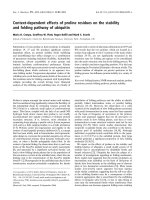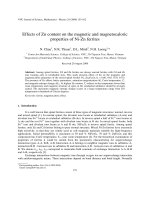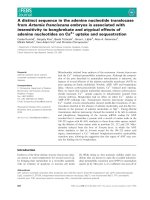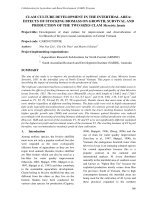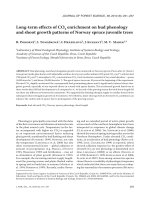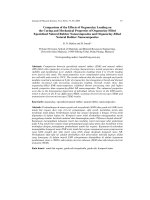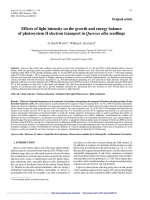Effects of mannan oligosasaccharide on immune function and disease resistance in pigs
Bạn đang xem bản rút gọn của tài liệu. Xem và tải ngay bản đầy đủ của tài liệu tại đây (1.33 MB, 163 trang )
EFFECTS OF MANNAN OLIGOSACCHARIDE ON IMMUNE FUNCTION
AND DISEASE RESISTANCE IN PIGS
BY
TUNG MINH CHE
DISSERTATION
Submitted in partial fulfillment of the requirements
for the degree of Doctor of Philosophy in Animal Sciences
in the Graduate College of the
University of Illinois at Urbana-Champaign, 2010
Urbana, Illinois
Doctoral Committee:
Professor James E. Pettigrew, Chair and Director of Research
Professor Keith W. Kelley
Professor Rodney W. Johnson
Professor William G. Van Alstine, Purdue University
Associate Professor Hans H. Stein
ABSTRACT
The 3 studies described below demonstrate the effects of mannan oligosaccharide
(MOS) on immune function and disease resistance in pigs. Study 1 evaluated whether MOS
in both in vivo and in vitro systems regulates cytokine production by alveolar macrophages
(AM) in response to in vitro microbial challenge models. The lipopolysaccharide (LPS)stimulated AM from MOS-fed pigs produced less tumor necrosis factor- (TNF-α) (P <
0.01) and more IL-10 (P = 0.051) than AM from the control-fed pigs. Dietary MOS did not
affect AM-produced cytokines induced by polyinosinic:polycytidylic acid (Poly I:C).
When applied in vitro, MOS suppressed LPS-induced TNF- (P < 0.001), but enhanced
LPS-induced IL-10 (P < 0.05). Further, TNF- production by AM stimulated with LPS (P
< 0.05) or Poly I:C (P < 0.001) was suppressed by a mannan-rich fraction (MRF). In order to
learn if MOS interacts with LPS receptors, AM were cultured with Polymyxin B, an
inhibitor of LPS-activated toll-like receptor (TLR) 4. Although Polymyxin B completely
inhibited AM-produced TNF- induced by LPS, it did not affect the ability of MOS to
regulate cytokine production in the absence of LPS. When added in vitro, both MOS and
MRF were also able to regulate constitutive production of TNF- in the absence of LPS.
Study 2 determined if various levels of dietary MOS affect growth and serum cytokine levels
in nursery pigs. No effect of MOS on growth was found. There were no differences in serum
levels of TNF- and IL-10, although these levels changed over time. Study 3 showed that
MOS altered nursery pigs‟ immune response to a porcine reproductive and respiratory
syndrome virus (PRRSV). Infection of PRRSV reduced pig performance and leukocytes (P
< 0.01), but increased serum inflammatory mediators and fever (P < 0.01). Dietary MOS
ii
prevented leukopenia at d 3 and 7 postinfection (PI) and tended to improve feed efficiency.
In infected pigs, MOS reduced fever at d 7 PI (P < 0.01) and serum TNF- at d 14 PI (P =
0.06). The gene expression profile in peripheral blood mononuclear cells and
bronchoalveolar lavage fluid cells at d 7 PI was characterized by using microarray and real
time RT-PCR. The MOS x PRRSV interaction altered the gene expression in the above
leukocytes (P < 0.05). In peripheral blood mononuclear cells, MOS increased the gene
expression of pattern recognition receptors, cytokines, and intracellular signaling molecules
in uninfected pigs, but reduced the gene expression of TLR4 and various types of key
cytokines and chemokines in infected pigs (P < 0.05). In bronchoalveolar lavage fluid cells,
MOS may promote a cytotoxic T cell immune response by enhancing MHCI mRNA
expression, but reduce the expression of complement system-associated molecules and 2‟,5‟oligoadenylate synthetase-1. The downregulation of inflammatory responses regulated by
MOS at d 7 PI was associated with several important canonical pathways such as triggering
receptor expressed on myeloid cells-1 signaling, hypoxia signaling, IL-4 signaling,
macropinocytosis signaling, and perhaps the alternative activation of macrophages. In
summary, MOS is a potent immunomodulator in both in vitro and in vivo systems. Dietary
inclusion of MOS in diets for pigs may bring benefits by boosting and maintaining the host‟s
disease resistance while preventing over-stimulation of the immune system.
Key
words:
Alveolar
macrophages
and
cytokine
immunomodulation; mannan oligosaccharide; pigs; PRRSV
iii
secretion;
disease
resistance;
DEDICATED
TO
MY MOTHER, WIFE, AND SON FOR ALL THEIR SPIRITUAL SUPPORTS
Most of us, swimming against the tides of trouble the world knows nothing about, need
only a bit of praise or encouragement -- and we will make the goal.
Jerome P. Fleishman
iv
ACKNOWLEDGEMENTS
I owe my deepest gratitude to my Ph.D. supervisor, Professor James E. Pettigrew,
whose constant encouragement and support throughout my study enabled me to learn and
understand an interesting area of research which was at the time entirely new to me. His
enthusiasm, understanding, and thoughtful guidance helped me to overcome all obstacles and
challenges in my research. He continually provided me with wise advice, skillful mentoring,
and great kindness.
I am indebted to all advisory committee members for their whole-hearted instruction,
persistent assistance, and extraordinary devotion. I am especially grateful to Professor Keith
W. Kelley and Professor Rodney W. Johnson, whose experience and broad insights enriched
my research and knowledge in the field of nutritional immunology. Their sound
interpretation and productive comments on the study results are invaluable. It is also an
honor for me to work with Professor William G. Van Alstine, who has contributed
considerably to the success of this research. I greatly acknowledge his steady cooperation,
generous patience, and kind help. I am grateful to Assoc. Professor Hans H. Stein for his
willingness to join my supervisory committee as well as for his valuable comments on the
format of this dissertation.
I would like to thank the laboratory technicians for supporting me in many different
faculties. Particularly, the assistance of JoElla Barnes from laboratory analyses to
experimental work in the field has been highly appreciated. A special thanks is also given to
Jing Chen for her willingness to help familiarize me with cell cultures at the initial stage of
my research.
v
Special thanks are offered to Alltech and its staff for financially supporting my
research and providing me with constant assistance. Especially, with all my heart I would
like to express my sincere gratitude to Dr. Karl Dawson, Dr. Colm Moran, and Alltech‟s vice
president, Mr. Aidan Connolly for their kind help, incessant encouragement, and valuable
discussions.
It is a pleasure to thank all my colleagues, friends, administrative staff, and farm crew
who made this research possible. A sincere gratitude is offered to my labmates for not only
their multiple contributions to the completion of this dissertation but also their sharing weal
and woe throughout my study.
I am very grateful to the Vietnam government for sponsoring my Ph.D. studies and
providing all necessary aid to complete this research. Lots of thanks to the staff of the
Vietnamese Ministry of Education and Training, whose long-standing support and tireless
contributions are deeply engraved on my memory.
I would like to acknowledge my wife, Anh T. Quach, for her patience, understanding,
support, and encouragement during my study. And to my newborn son, Van K. Che, who
inspirits me to finish this dissertation. They make my life complete.
Lastly, and most importantly, I wish to thank my beloved mother, Ngot T. Le, for her
nourishing, teaching, and never-ending support. From the bottom of my heart, her great
affection and lofty sacrifice for my life and bright future is deeply impressed on my memory.
vi
TABLE OF CONTENTS
LIST OF ABBREVIATIONS .................................................................................................... viii
CHAPTER 1: LITERATURE REVIEW ....................................................................................... 1
Mannan Oligosaccharide ................................................................................................... 1
The Immune System .......................................................................................................... 8
Porcine Reproductive and Respiratory Syndrome ........................................................... 16
Literature Cited ................................................................................................................ 22
CHAPTER 2: MANNAN OLIGOSACCHARIDE REGULATES CYTOKINE
PRODUCTION BY ALVEOLAR MACROPHAGES IN NURSERY PIGS ............................. 38
Abstract ............................................................................................................................ 38
Introduction ...................................................................................................................... 39
Materials and Methods ..................................................................................................... 40
Results .............................................................................................................................. 45
Discussion ........................................................................................................................ 47
Literature Cited .................................................................................................................52
Figures and Tables ........................................................................................................... 58
CHAPTER 3: EFFECTS OF MANNAN OLIGOSACCHARIDE ON IMMUNE RESPONSE
AND GROWTH PERFORMANCE IN NURSERY PIGS EXPERIMENTALLY INFECTED
WITH PORCINE REPRODUCTIVE AND RESPIRATORY SYNDROME VIRUS ............... 68
Abstract ............................................................................................................................ 68
Introduction ...................................................................................................................... 69
Materials and Methods ..................................................................................................... 70
Results .............................................................................................................................. 74
Discussion ........................................................................................................................ 78
Literature Cited ................................................................................................................ 82
Figures and Tables ........................................................................................................... 89
CHAPTER 4: MANNAN OLIGOSACCHARIDE MODULATES GENE EXPRESSION
PROFILE IN PIGS EXPERIMENTALLY INFECTED WITH PORCINE REPRODUCTIVE
AND RESPIRATORY SYNDROME VIRUS .......................................................................... 102
Abstract .......................................................................................................................... 102
Introduction .................................................................................................................... 103
Materials and Methods ................................................................................................... 104
Results ............................................................................................................................ 111
Discussion ...................................................................................................................... 117
Literature Cited .............................................................................................................. 124
Figures and Tables ......................................................................................................... 131
CHAPTER 5: GENERAL RESEARCH SUMMARY .............................................................. 146
AUTHOR‟S BIOGRAPHY ........................................................................................................152
vii
LIST OF ABBREVIATIONS
ADFI
average daily feed intake
ADG
average daily gain
AM
alveolar macrophages
ANOVA
analysis of variance
AP
activation protein
APP
acute phase proteins
APRIL
a proliferation-inducing ligand
ARG
arginase
BALF
bronchoalveolar lavage fluid
BW
body weight
CD
cluster of differentiation
cDNA
complementary deoxyribonucleic acid
CON
uninfected control-fed pigs
CRP
C-reactive protein
C1QA
complement component 1
CV
coefficient of variation
d
day
DDX
dead box polypeptide
DMEM
dubelco‟s modified eagle medium
ELISA
enzyme-linked immunosorbent assay
FCGRT
fragment crystallizable of IgG, receptor, and transporter
viii
FDR
false discovery rate
G:F
gain to feed ratio
GIT
gastrointestinal tract
GLM
general linear model
GluF
glucan fraction
HIF
hypoxia-inducible factor
Hp
haptoglobin
ICON
infected control-fed pigs
IFN
interferon
Ig
immunoglobulin
IL
interleukine
IMOS
infected mannan oligosaccharide-fed pigs
IPA
ingenuity pathway analysis
LPS
lipopolysaccharide
M
microfold
MCP
monocyte chemotactic protein
MHC
major histocompatibility complex
min
minutes
MIP
macrophage inflammatory protein
MOS
mannan oligosaccharide
MR
mannose receptor
MRF
mannan-rich fraction
MyD
myeloid differentiation factor
ix
mRNA
messenger ribonucleic acid
NA
neutralizing antibodies
NRC
national research council
OAS
oligoadenylate synthetase
PBMC
peripheral blood mononuclear cells
PBS
phosphate buffered saline
PCR
polymerase chain reaction
PEC-60
peptide with N-terminal glutamic acid, C-terminal cysteine, and a total
of 60 residues
PI
postinfection
PI3K
phosphoinositide 3-kinase
PMB
polymyxin B
Poly I:C
polyinosinic:polycytidylic acid
PRRS
porcine reproductive and respiratory syndrome
PRRSV
porcine reproductive and respiratory syndrome virus
PW
postweaning
p38 MAPK
p38 mitogen-activated protein kinase
p53
tumor protein 53
RT
rectal temperature
RT-PCR
reverse transcription polymerase chain reaction
SAS
statistical analysis software
S/P
sample to positive ratio
Th
T helper
x
TLR
toll-like receptor
TNF
tumor necrosis factor
TREM
triggering receptor expressed on myeloid cells
WBC
white blood cells
wk
week
xi
CHAPTER 1
LITERATURE REVIEW
MANNAN OLIGOSACCHARIDE
Introduction
Glycobiology is a relatively new field of study in the world of science. In the past
decades, discoveries in the field of glycobiology have revealed the critical role of
carbohydrates in the mechanisms of immunity (Dwek, 1996; Munro, 2000; Axford, 2001).
These discoveries will lead to the ability to use these functional carbohydrates, with a
reduced use of antibiotics, in diets to improve performance and health of animals. There has
of late been increasing pressure on the livestock industry to decrease the use of antibiotics
due to the potential development of antibiotic resistance (Pettigrew, 2006; Stein and Kil,
2006). Among carbohydrates, mannan oligosaccharide (MOS), derived from the yeast cell
wall of Saccharomyces cerevisiae, has been shown to improve animal performance and
health through several mechanisms such as prevention of pathogens from binding to the
gastrointestinal tract (GIT), alteration of GIT microbial populations, and enhancement of
immune functions.
Growth Performance
Swine. Addition of MOS to a diet has resulted in a large variation in growth
performance response of pigs. Some researchers have reported little response in ADG, ADFI,
and G:F when MOS was fed to weaned pigs. LeMieux et al. (2003) reported that nursery pigs
fed diets with 0, 0.2, or 0.3% MOS supplementation showed no improvement in growth
1
performance. With similar dietary inclusion levels of MOS, Davis et al. (2004a) found no
effect of MOS on growth response of nursery pigs. In other studies, however, increases in
growth performance of pigs have been demonstrated (Dvorak and Jacques, 1998; Kim et al.,
2000; Davis et al., 2004b). Under commercial conditions, differences in growth response to
dietary MOS have also been reported. Rozeboom et al. (2005) investigated effects of MOS
on the performance of pigs on 2 large-scale commercial farms (A and B) and one university
research farm (C). They demonstrated that growth improvements with MOS on Farms A and
B were not significant, but pigs on Farm C had better ADG, ADFI, and G:F. Recently, in a
study assessing performance of nursery pigs in 7 trials, the pooled data suggested that
addition of MOS to a weaned pig‟s diet increased ADFI and ADG of piglets (Corrigan et al.,
2008). Growth performance responses to MOS supplementation are variable, being
especially related to growth rate of pigs (Miguel et al., 2004). The meta-analysis of Miguel et
al. (2004) suggested that MOS had little or no response in pigs with high growth rate (> 180
g/d) during the first 1 to 2 wk postweaning (PW).
Mannan oligosaccharide has the potential to partly replace pharmacological levels of
trace minerals or may be alternative to antibiotics in nursery diets. In a series of experiments,
LeMieux et al. (2003) found that diets with 0.2% MOS supplementation during phase 2
increased the growth performance of pigs when excess zinc was not included in the diet.
When Zn included in the diet at a level of 3000 ppm, there was no difference in growth
performance between pigs fed MOS and those fed the control. Davis et al. (2004a) showed
that adding MOS resulted in an improved growth response if dietary zinc levels were
restricted to levels of 200 or 500 ppm. These results indicate that the amount of zinc which is
commonly added to the nursery pig diet can be lowered in MOS-supplemented diets. This
2
may help reduce the negative impact of excess zinc on the environment because of reduced
zinc excretion. Similarly, the benefit of growth in pigs fed MOS was also substantiated when
the level of copper in the diet was restricted (Davis et al., 2002a). In addition, MOS may be
considered alternative to antibiotics in certain cases. For instance, Rozeboom et al. (2005)
evaluated the effect of MOS on the number of medical treatments, removal rate, and
mortality of nursery pigs reared under commercial farm or university research farm levels.
They reported that MOS was likely an alternative to tylosin and sulfamethazine as a growth
promotant in nursery diets.
Most of the data obtained from the above studies, whether conducted at a university
research farm or under commercial conditions, illustrate the beneficial effects of MOS on
growth performance of young pigs. The favorable effect of MOS on growth performance in
diets with low levels of copper and zinc seems to be promising if the proportions of these
trace minerals in nursery pig diets are strictly regulated as a concern of environmental
pollution. The potential of MOS as a growth-promoting alternative to antibiotics needs
further investigation.
Poultry. Several studies have been conducted to investigate the effect of dietary MOS
on growth performance in poultry. The inclusion of MOS in poultry diets has resulted in
varying responses of growth performance. Some studies have reported no effect of MOS on
the performance of poultry. In an experiment with broiler chickens, a diet with 0.5% MOS
supplementation did not significantly produce better performance than the control (Geier et
al., 2009). Fritts and Waldroup (2003) reported that turkey poults fed 0.05 or 0.1% MOS
performed the same as those consuming the negative control. In contrast, other researchers
found beneficial effects on the growth of turkeys. Zdunczyk et al. (2005) indicated that
3
turkeys fed diets with medium and high levels of MOS had greater BW at the age of 16 wk
than those fed the control. Also, Sims et al. (2004) showed that the BW of turkeys fed 0.05 or
0.1% was heavier than that of turkeys fed the control. Furthermore, in a meta-analysis,
Hooge (2004a,b) evaluated the effects of dietary MOS on the performance of broiler
chickens and turkeys. The results showed that diets containing MOS significantly improved
final BW compared to control diets but gave statistically equivalent BW compared to diets
containing sub-therapeutic levels of antibiotics. In brief, on the basis of these available data,
it is suggested that MOS has potential as a growth promoter for poultry.
Other Species. The growth-enhancing effect of MOS has also been studied in other
types of animals such as cattle, rabbits, and fish. Heinrichs et al. (2003) reported that ADFI
was increased in MOS-fed calves compared to antibiotic-fed calves, but no difference in
growth was found during the experimental period of 5 wk. A similar response was also
obtained by Terre et al. (2007) when calves were fed 4 g of MOS per day. In rabbits
consuming different levels of MOS ranging from 0.05 to 0.2%, feed efficiency was improved
compared to the control rabbits. In a study with rainbow trout, the results also showed that
MOS improved feed efficiency as well as growth performance (Staykov et al., 2007).
Changes in Microbial Population through Agglutination of Pathogens
Mannan oligosaccharide, derived from the cell wall of Sacchromyces cerevisiae, is
believed to promote gut health by preventing pathogens from attaching to the epithelial
surface of the intestines (Kocher and Tucker, 2005). Mannan, present in MOS, offers a
competitive binding site for a certain class of bacteria (Oyofo et al., 1989a, b). One of the
basic modes of action of MOS is to block the attachment of pathogenic bacteria containing
4
Type I fimbriae to the intestinal wall of animals. Hence, the attached harmful bacteria are
taken with digesta to the large intestine and then excreted in feces. In a survey, it was
demonstrated that approximately 70% of 77 Escherichia coli strains and 53% of 30
Salmonella species possessing Type 1 fimbriae were sensitive to mannan (Finuance et al.,
1999). In order to confirm that MOS inhibits pathogen colonization, Spring et al. (2000)
screened different bacterial strains for their ability to agglutinate MOS in yeast cell
preparations. Five of 7 strains of Escherichia coli and 7 of 10 strains of Salmonella
typhimurium and Salmonella enteriditis were agglutinated by MOS and yeast cells. It has
been shown that MOS changed microbial populations in the GIT of young pigs (Miguel et
al., 2006). The reduction in the number of pathogenic bacteria perhaps results in a better gut
microflora through which diarrhea is possibly prevented.
Fecal Score Consistency and Diarrhea
Addition of MOS to diets has been shown to result in improved fecal consistency and
reduce diarrhea in several types of animals. Castillo et al. (2008) showed that pigs fed 0.2%
MOS had more normally shaped feces than those fed the control. In another study with
weaned pigs, the incidence of diarrhea and number of diarrhea days were lower in the MOSfed group than in the control group (Grela et al., 2006). In calves, fecal scores were also
improved when calves were fed 4 g of MOS daily for 5 wk (Heinrichs et al., 2003). The
beneficial effect of MOS on fecal consistency and diarrhea may be associated with the ability
of MOS to block the colonization of enteric pathogens to the GIT wall.
5
Immune Responses to Dietary MOS
Small oligosaccharides have been shown to exert a variety of effects on the immune
system and to potentially modulate the immune responses (Bland et al., 2004). More
available data about the role of oligosaccharides as immunomodulators has been increasingly
generated. Among oligosaccharides, MOS has been reported to influence the innate and
adaptive immunity.
Several studies have demonstrated effects of MOS on the nonspecific cellular
immunity. In an in vitro experiment, the stimulation of phagocytic activity of rat
macrophages by MOS was shown to be dose-dependent (Newman, 1995). Davis et al.
(2004b) also reported that phagocytic macrophages isolated from the jejuna lamina propria of
pigs fed MOS consumed a greater number of sheep red blood cells per phagocytic
macrophage than did phagocytic macrophages isolated from pigs fed the control diet. These
data indicate that MOS is a potent immunostimulator. On the other hand, MOS reduced the
inflammatory tissue response in poultry. Cotter and Weinner (1997) showed that inclusion of
MOS in the diets of replacement pullets at a level of 1 g/kg reduced the intensity of the wattle
hypersensitivity reaction in both 8- and 10-wk-old pullets subjected to 3 successive
exposures to antigen at 2-wk intervals commencing at 6 wk of age. The mechanism of MOS
in reducing inflammation is unknown, but may be associated with the expression level of
pattern recognition receptors (PRR) involved in antigen binding and secretion of cytokines.
Singboottra et al. (2006) found that reduced expression of IL-6 by a mannan-rich fraction
was mediated through a transitory decrease in the expression of toll-like receptor (TLR) 4.
This receptor, when activated, triggers a cascade of inflammatory cytokine production.
6
The effects of MOS on lymphocyte proliferation and leukocyte populations have been
evaluated. Mannan oligosaccharide appeared not to affect in vitro lymphocyte proliferation.
In a series of experiments conducted by Davis et al. (2002a) and Davis et al. (2004a,b),
lymphocytes from pigs fed different levels of MOS and copper or zinc were collected and
lymphocyte proliferation was measured in vitro by unstimulating or stimulating lymphocytes
with phytohemagglutinin or pokeweek mitogen. The results showed no effect of dietary
MOS on lymphocyte proliferation. However, in the presence of Zn, MOS modulated
lymphocyte proliferation by increasing the number of pokeweek-stimulated lymphocytes.
Although not affecting in vitro lymphocyte proliferation, feeding MOS to animals increased
the proportion of peripheral lymphocytes. Davis et al. (2004b) found that pigs fed 0.3% MOS
had a greater lymphocyte percentage than those fed the control, but there was no difference
in the number of lymphocytes between MOS-fed pigs and control-fed pigs. A similar
response was also shown in a study of Swanson et al. (2002) in which dogs were fed 0 or
0.1% MOS. Moreover, dietary MOS intermittently modified the proportions of cluster of
differentiation (CD) 14 and CD14 major histocompatibility complex (MHC) II leukocytes in
the blood and jejuna lamina propria of weanling pigs (Davis et al., 2004b). The increase in
CD8 T cells was also documented in MOS-fed pigs. This is very important in diseases
associated with viral infections.
Mannan oligosaccharide has also been shown to influence the adaptive immunity. In
poultry, Savage et al. (1996) reported an increase in plasma IgG and bile IgA in poults fed
diets supplemented with 0.11% MOS. The increase in antibody response to MOS indicates
that MOS may contain components which probably have the ability to elicit powerful
antigenic properties. Shashidhara and Devegowda (2003), investigating influence of MOS on
7
infectious bursal disease virus antibody titers in broiler breeder and progeny, showed that
antibody responses against infectious bursal disease virus in breeder and progeny were higher
in the MOS group. In pigs, a study with sows receiving MOS 14 d prefarrowing and
throughout lactation observed higher concentrations of colostral IgM compared to the
untreated sows (Newman and Newman, 2001). Another study also indicated that feeding
MOS to sows increased IgG and IgA levels in colostrum (O‟Quinn et al., 2001).
Furthermore, Franklin et al. (2005) reported that supplementation of MOS to cows during the
dry period enhanced their immune response to rotavirus and tended to enhance the
subsequent transfer of rotavirus antibodies to calves. In addition, Davis et al. (2004b) showed
that pigs fed diets containing MOS intermittently affected selected components of the young
pigs‟ immune function both systemically and enterically.
Several benefits from the use of MOS in animals have been discussed, but the
improved immunity of animals by MOS has remained unclear. The data reviewed suggest
that MOS may directly interact with immune cells and induce changes in expression of
molecules involving immune regulation such as cytokines, chemokines, PRR, etc. Thus, the
specific effects of MOS on immune responses need to be evaluated under various conditions.
Understanding of the mechanisms of MOS in modulation of the immune responses of pigs is
necessary to gain maximum benefit from MOS under practical application.
THE IMMUNE SYSTEM
Innate and Adaptive Immunity
The immune system has evolved to protect the multicelllular organism from
pathogens. It can be divided into 2 systems of immunity: innate immunity and adaptive
8
immunity. The innate immune system is universal and the first line of host defense against
infection. It non-specifically responds to an antigen at the first contact. This immune
response is primarily mediated by phagocytic cells, natural killer cells, mast cells,
eosinophils, and soluble molecules such as complement factors, acute phase reactants and
cytokines (Janeway and Medzhitov, 2002). The phagocytic cells, especially neutrophils and
monocytes/macrophages, eliminate the microorganisms by phagocytosis and subsequent
degradation by intracellular enzymes (Underhill and Ozinsky, 2002). The innate immune
system is characterized by immediate activation of effectors, quick response, perfect selfnonself discrimination, non-clonal distribution, and recognition of conserved molecular
patterns of microbes. The antigen presenting cells, i.e. macrophages and dendritic cells, not
only are capable of phagocytosis but also can process and present antigens to antigen-specific
T lymphocytes (Jenkins et al., 2001; Trombetta and Mellman, 2005). In this way they form a
bridge between innate and adaptive immunity.
Adaptive immunity refers to antigen-specific immune response and is more complex
than the innate immunity. It provides a second, comprehensive line of defense, capable of
specifically recognizing foreign antigens, developing an immunological memory of infection,
and rearranging receptor gene segments. However, it takes a few days for the adaptive
immunity to begin after the initial infection (Williams and Bevan, 2007). Cells involved in an
adaptive immune response include T lymphocytes, B lymphocytes, and antigen presenting
cells.
There are 2 main subsets of T lymphocytes, distinguished by the presence of cell
surface molecules known as CD4 and CD8. T lymphocytes expressing CD4 are also known
as helper T (Th) cells, and are regarded as being the most prolific cytokine producers
9
(Jenkins et al., 2001). This subset can be further sub-divided into Th1 and Th2, and the
cytokines they produce are known as Th1-type cytokines and Th2-type cytokines (Szabo et
al., 2003; Lippolis, 2008). The Th1-type cytokines tend to produce the pro-inflammatory
responses responsible for killing intracellular pathogens and interferon (IFN)-γ is the main
Th1 cytokine. Excessive pro-inflammatory responses can lead to uncontrolled tissue damage,
so there needs to be a mechanism to counteract this. The Th2-type cytokines include
interleukins 4, 5, and 13, which are associated with the promotion of IgE and eosinophilic
responses in atopic allergies, and also IL-10, which has more of an anti-inflammatory effect.
In excess, Th2 responses will antagonize the Th1-mediated microbicidal action. The optimal
scenario would therefore seem to be that animals should produce a well-balanced Th1 and
Th2 response, suited to the immune challenge.
There are 3 main types of professional antigen-presenting cells, consisting of
dendritic cells, macrophages, and B lymphocytes. These cells take up antigens in peripheral
tissues, process them into proteolytic peptides, and load these peptides onto MHC class I and
II molecules (Guermonprez et al., 2002; McHeyzer-Williams and McHeyzer-Williams,
2005). In addition to the professional antigen-presenting cells, any nucleated cell in the body
can present a complex of antigen and MHCI bound on its surface to CD8 T cells or cytotoxic
T cells. Naive CD8 precursors have no cytotoxic activity and must undergo an activation
process requiring 1 to 3 d for maximal activity (Wong and Pamer, 2003; Williams and
Bevan, 2007). This activation process requires T cell receptor-stimulated induction of
cytokine receptors (e.g., IL-2 and IL-6), which then induce the expression of granule
components, including perforin and granzymes. In contrast, macrophages and dendritic cells
present antigens to Th1 cells through MHCII, whereas B cells present antigens to Th2 cells.
10
An antigen-presenting process occurs in secondary lymphoid organs and thereafter initiating
antigen-specific immune responses, or immunological tolerance (Guermonprez et al., 2002;
Trombetta and Mellman, 2005). The recognition of an antigen-MHC complex by a specific
mature T lymphocyte induces clonal proliferation and differentiation into various memory T
and B cells, effector T cells, and antibody-secreting plasma cells.
Pattern Recognition Receptors and MOS
The innate immune system uses several different receptors to recognize and respond
to antigenic stimulators which are characteristic of microbial surfaces but are not found on
the host cells (Janeway and Medzhitov, 2002). These receptors, termed PRR, are diverse,
including TLR, scavenger receptors, and lectin receptors such as the mannose receptor (MR).
In mammals TLR family is known to consist of 11 members (TLR1 to TLR11) and can
recognize distinct microbial components (Takeda et al., 2003; Akira and Takeda, 2004). For
instance, TLR4 is a receptor specifically involved in the recognition of lipopolysaccharide, a
major cell wall component of gram-negative bacteria, whereas MR is able to recognize a
wide range of gram-negative and gram-positive bacteria, yeasts, parasites, and mycobacteria
(Stahl and Ezekowitz, 1998; Raetz and Whitfield, 2002). Activation of PRR triggers
intracellular signaling cascades leading to the biosynthesis of cytokines, such as IL-1, IL-6,
IL-10, tumor necrosis factor (TNF)-, and IFN, and induction of co-stimulatory molecules
required for the adaptive immune response.
Mannan oligosaccharide has been assumed to have a direct effect on the immune cells
through its mannan molecule. Recent discovery has revealed that TLR4 and MR may be
involved in the recognition of mannan. It has been found that MR on macrophages and other
11
cells recognizes mannan (Tizard et al., 1989; Davis et al., 2002b). In other words,
Singboottra et al. (2006) reported that altered cytokine expression of chicken macrophages
stimulated with a mannan-rich fraction was mediated via a transitory decrease in the mRNA
expression of TLR4. Additionally, it was shown that TLR4 recognized mannan and mannanassociated molecules (Sheng et al., 2006). It may be speculated that activation of
macrophages by MOS is likely involved in both MR and TLR4 whose expression levels
would determine the immune responses of macrophages to bacterial or viral stimulations.
Variations in immunomodulatory characteristics among mannan-containing products can be
ascribed to a polymerization degree of mannan (Bland et al., 2004), types of terminal
linkages of mannan sequences (Young et al., 1998), or types of mannan (Djeraba and Quere,
2000; Sheng et al., 2006). Thus, evaluation of MOS effects on immune function in pigs is
necessary because benefits, such as better performance and enhanced disease resistance may
result from its efficient immunomodulation.
Gastrointestinal Immunity in Association with MOS
Integrity and well-being of the GIT of animals is protected by several defense
mechanisms including peristaltic movements of the intestine, shedding of epithelial cells,
gastric acidity, bile acids, antimicrobial peptides, mucus as well as water secretion, and
balanced microflora. Mannan oligosaccharide included in a nursery pig diet may promote a
healthy GIT by inhibiting intestinal colonization of enteric pathogens and enhancing the
host‟s immunity. First, MOS contains yeast cell wall fragments. These fragments contain
mannans, which competitively bind gram-negative bacteria, preventing their attachment to
the intestinal mucosa (Oyofo et al., 1989a,b; Finuance et al., 1999). Because mannans are not
12
digestible in the intestines (Longe et al., 1982), the bound pathogens likely pass through the
digestive tract. Recently, it has been demonstrated that certain bacterial strains, such as
lactobacilli, bifidobacteria, and L.johnsonii La1 possess immunostimulatory properties and
can enhance innate immune mechanisms (Blum et al., 2002; Herich and Levkut, 2002;
Desbonnet et al., 2008). Microbial populations altered by MOS therefore possibly affect
mucosal and systemic immune responses of pigs. Second, increases in immunoglobulin
concentrations in plasma, colostrum, and bile suggest that MOS may have a direct effect on
mucosal as well as systemic immunity if it is taken up by microfold (M) cells located on the
GIT and acts as an immunostimulatory agent. The M cells are distinctive epithelial cells and
serve as a critical component in the cascade from antigen deposition at mucosal surfaces to
transepithelial transport and development of mucosal immunity (Kraehenbuhl, 2000).
Antigens are transported into mucosal lymphoid tissues by M cells, which are only present in
the follicle-associated epithelium overlaying organized lymphoid tissue in the nasal and oral
cavities as well as the intestine and bronchi (Makala et al., 2002). Generally, there has been
little information about the uptake of MOS mediated by receptors of M cells, but the
systemic immunity regulated by MOS may be associated with modulated mucosal immunity
and function of M cells.
Lung Inflammatory Responses
Respiratory diseases caused by viruses, such as PRRSV, swine influenza, porcine
respiratory coronavirus, and porcine circo virus are common in pigs (Thacker, 2001; Paton
and Done, 2002). The lung is in direct and continuous exposure to the surrounding
environment. In spite of continual contact with immunologically potent challenges,
13
inflammation in the lung is tightly controlled to keep the host animal in a healthy and noninflamed state. Inflammatory responses can be beneficial or detrimental to the host and
categorized into as acute and chronic in nature.
Inflammatory responses are typically immediate in nature and characterized by
changes in vascular tissues in order to eliminate harmful stimuli, e.g. pathogens. Leukocytes,
such as neutrophils, natural killer cells, macrophages and lymphocytes, various cytokines and
chemokines, and other serum components play a role in both triggering and controlling
inflammation (Lazarus, 1986). Intercellular communication occurs using various mediators
and messengers that include cytokines, leukotrienes, prostaglandins, thromboxane, plateletactivating factor, acute phase proteins, and the various cell adhesion molecules. In the first
stages of inflammation, neutrophils and natural killer cells are the first WBC population to
arrive and affect the host inflammatory response (Guo and Wand, 2002; Kohlmeier and
Woodland, 2009). Neutrophils and natural killer cells infiltrate the lungs in response to the
various mediators of acute inflammation. During the attraction and activation of neutrophils,
activated phagocytic cells, especially macrophages, are also recruited to the site of
inflammation. Due to inflammation, cytokines and chemokines are secreted rapidly and early
following injury or infection. Interferon-, TNF-, IL-1, and IL-6 are early cytokines
produced during the initial stage of an infection (Murtaugh et al., 1996; Murtaugh and Foss,
2002; Van Reeth et al., 2002). Chemokines are important mediators of inflammation in the
respiratory tract. Chemokines are small polypeptides that control adhesion, chemotaxis, and
activation of leukocyte populations (Rot and Andrian, 2004; Allen et al., 2007). Some
chemokines are constitutively expressed, whereas others are either up or downregulated in
association with inflammation. A variety of serum proteins are actively involved in acute
14
